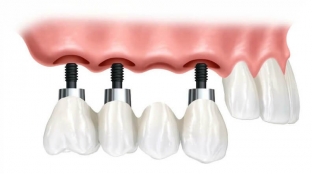Tooth implantation is known to be required in case of loss due to trauma or severe destruction caused by a carious lesion. In any case, the installation of an implant is required if the tooth cannot be restored by other, less drastic methods. At the same time, one-stage implantation is one of the most popular methods of dental prosthetics both among doctors and patients. Therefore, estet-portal.com will talk about the features, benefits, indications and contraindications for the use of this type of prosthetics.
What is the Immediate Dental Implant Procedure
Simultaneous implantation – This is a method of dental prosthetics, which consists in the installation of an implant immediately after tooth extraction within one visit. Most often, this type of implantation is used to restore teeth in the smile zone, that is, in the most noticeable areas for the surroundings; or in case of loss of teeth after injuries, when the jawbone retains its integrity. To reduce the recovery time, as well as to minimize the discomfort of the patient, simultaneous implantation allows, if necessary, to restore several teeth at the same time.
Specialists of innovative dentistry "On Smolenskaya", having all the necessary knowledge and skills, guarantee high quality and long-lasting results after such procedures, however, they warn that implantation in one session is not possible in every case:
- in what cases is it possible to perform simultaneous implantation;
- what are the benefits of immediate implantation for the patient;
- whether immediate implantation is associated with any risks.
Simultaneous implantation – is a method of dental prosthetics, which consists in the installation of an implant immediately after tooth extraction within one visit.

In what cases is simultaneous implantation possible
The most important, but not the only condition for simultaneous implantation – patient's jaw health. However, there are a number of factors that the dentist must consider before using this method of dental prosthetics:
- absence of inflammatory processes at the site of implantation;
- tight fit of the gum to the underlying bone;
- sufficient volume of jawbone;
- proper (healthy) condition, density and strength of the jawbone.
The most important, but not the only condition for simultaneous implantation – patient's jaw health.
Contraindications for immediate implantation are:
- diabetes mellitus;
- bruxism;
- osteoporosis;
- recent heart attacks, strokes;
- exacerbation of diseases.
Dentists also warn that smoking, although not a habit, is a direct contraindication to dental prosthetics, increases the risk of implant rejection.
What are the advantages of immediate implantation for the patient
The main advantages of immediate implantation for the patient are obvious:
- saving time (the ability to restore teeth in one visit, no need for a long wait for the implant to be ready);
- excellent result in terms of aesthetics (especially in the frontal zone) – accurate gum contour, matched implant color identical to natural and other aspects;
- rapid recovery of speech and chewing functions;
- preservation of the original soft tissue contour;
- absence of factors provoking bone loss;
- patient comfort, including psychological.
The advantages of single-stage implantation are much greater than the disadvantages: this method of prosthetics allows you to achieve excellent aesthetic results and return the functionality of the tooth in the shortest possible time.
Are there any risks associated with immediate implantation
Like any surgical procedure, immediate dental implants come with certain risks. For example, there is a very small chance of implant rejection. However, subject to all the rules and norms of the procedure by the dentist, as well as all the recommendations of the doctor – patient, this risk is minimized.
The following factors are mentioned that may increase the risk of implant rejection:
- severe gum injury as a result of tooth extraction;
- accumulation of plaque around an unprotected gum socket;
- Inadequate fixation of the implant;
- Immediate loading of the denture with a temporary crown.
Dentists say that the small risk of rejection of the prosthesis after one-stage implantation is fully justified due to the excellent results that this procedure allows to achieve in the shortest possible time. However, it is very important to exclude all contraindications to this method of prosthetics in order to ensure safety, durability and excellent aesthetic performance after simultaneous dental implantation.






Add a comment